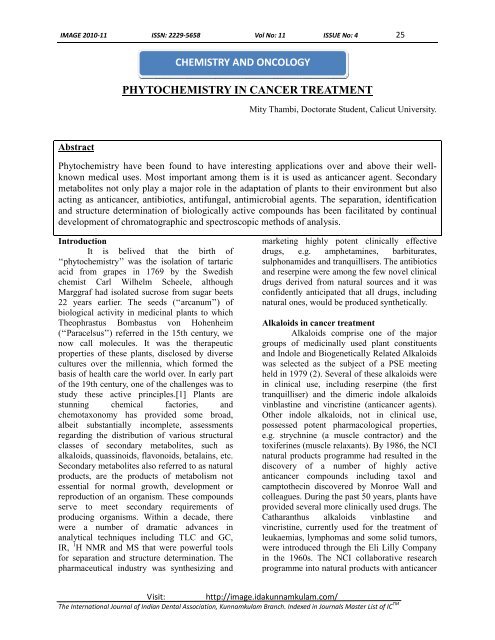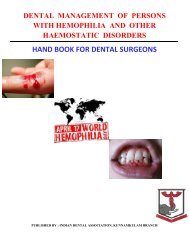'satisfactory smile' with a restorative approach - Indian Dental ...
'satisfactory smile' with a restorative approach - Indian Dental ...
'satisfactory smile' with a restorative approach - Indian Dental ...
You also want an ePaper? Increase the reach of your titles
YUMPU automatically turns print PDFs into web optimized ePapers that Google loves.
IMAGE 2010-11 ISSN: 2229-5658 Vol No: 11 ISSUE No: 4 25<br />
Abstract<br />
CHEMISTRY AND ONCOLOGY<br />
\\<br />
PHYTOCHEMISTRY IN CANCER TREATMENT<br />
Mity Thambi, Doctorate Student, Calicut University.<br />
Phytochemistry have been found to have interesting applications over and above their wellknown<br />
medical uses. Most important among them is it is used as anticancer agent. Secondary<br />
metabolites not only play a major role in the adaptation of plants to their environment but also<br />
acting as anticancer, antibiotics, antifungal, antimicrobial agents. The separation, identification<br />
and structure determination of biologically active compounds has been facilitated by continual<br />
development of chromatographic and spectroscopic methods of analysis.<br />
Introduction<br />
It is belived that the birth of<br />
ëëphytochemistryíí was the isolation of tartaric<br />
acid from grapes in 1769 by the Swedish<br />
chemist Carl Wilhelm Scheele, although<br />
Marggraf had isolated sucrose from sugar beets<br />
22 years earlier. The seeds (ëëarcanumíí) of<br />
biological activity in medicinal plants to which<br />
Theophrastus Bombastus von Hohenheim<br />
(ëëParacelsusíí) referred in the 15th century, we<br />
now call molecules. It was the therapeutic<br />
properties of these plants, disclosed by diverse<br />
cultures over the millennia, which formed the<br />
basis of health care the world over. In early part<br />
of the 19th century, one of the challenges was to<br />
study these active principles.[1] Plants are<br />
stunning chemical factories, and<br />
chemotaxonomy has provided some broad,<br />
albeit substantially incomplete, assessments<br />
regarding the distribution of various structural<br />
classes of secondary metabolites, such as<br />
alkaloids, quassinoids, flavonoids, betalains, etc.<br />
Secondary metabolites also referred to as natural<br />
products, are the products of metabolism not<br />
essential for normal growth, development or<br />
reproduction of an organism. These compounds<br />
serve to meet secondary requirements of<br />
producing organisms. Within a decade, there<br />
were a number of dramatic advances in<br />
analytical techniques including TLC and GC,<br />
IR, 1 H NMR and MS that were powerful tools<br />
for separation and structure determination. The<br />
pharmaceutical industry was synthesizing and<br />
marketing highly potent clinically effective<br />
drugs, e.g. amphetamines, barbiturates,<br />
sulphonamides and tranquillisers. The antibiotics<br />
and reserpine were among the few novel clinical<br />
drugs derived from natural sources and it was<br />
confidently anticipated that all drugs, including<br />
natural ones, would be produced synthetically.<br />
Alkaloids in cancer treatment<br />
Alkaloids comprise one of the major<br />
groups of medicinally used plant constituents<br />
and Indole and Biogenetically Related Alkaloids<br />
was selected as the subject of a PSE meeting<br />
held in 1979 (2). Several of these alkaloids were<br />
in clinical use, including reserpine (the first<br />
tranquilliser) and the dimeric indole alkaloids<br />
vinblastine and vincristine (anticancer agents).<br />
Other indole alkaloids, not in clinical use,<br />
possessed potent pharmacological properties,<br />
e.g. strychnine (a muscle contractor) and the<br />
toxiferines (muscle relaxants). By 1986, the NCI<br />
natural products programme had resulted in the<br />
discovery of a number of highly active<br />
anticancer compounds including taxol and<br />
camptothecin discovered by Monroe Wall and<br />
colleagues. During the past 50 years, plants have<br />
provided several more clinically used drugs. The<br />
Catharanthus alkaloids vinblastine and<br />
vincristine, currently used for the treatment of<br />
leukaemias, lymphomas and some solid tumors,<br />
were introduced through the Eli Lilly Company<br />
in the 1960s. The NCI collaborative research<br />
programme into natural products <strong>with</strong> anticancer<br />
Visit: http://image.idakunnamkulam.com/<br />
The International Journal of <strong>Indian</strong> <strong>Dental</strong> Association, Kunnamkulam Branch. Indexed in Journals Master List of IC TM



